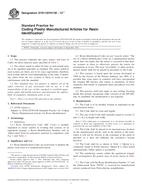We need your consent to use the individual data so that you can see information about your interests, among other things. Click "OK" to give your consent.
ASTM D7611/D7611M-13e1
Standard Practice for Coding Plastic Manufactured Articles for Resin Identification (Includes all amendments And changes 12/4/2018).
Automatically translated name:
Standard Practice for Coding Plastic Manufactured Articles for Resin Identification
STANDARD published on 1.6.2013
The information about the standard:
Designation standards: ASTM D7611/D7611M-13e1
Note: WITHDRAWN
Publication date standards: 1.6.2013
SKU: NS-38828
The number of pages: 4
Approximate weight : 12 g (0.03 lbs)
Country: American technical standard
Category: Technical standards ASTM
The category - similar standards:
Annotation of standard text ASTM D7611/D7611M-13e1 :
Keywords:
plastics, Resin Identification Code, ICS Number Code 83.140.01 (Rubber and plastic products in general)
Additional information
| Significance and Use |
|
4.1 Resin Identification Codes are used solely to identify the plastic resin used in a manufactured article. 4.2 Resin Identification Codes are not “recycle codes.” The use of a Resin Identification Code on a manufactured plastic article does not imply that the article is recycled or that there are systems in place to effectively process the article for reclamation or re-use. The term “recyclable” or other environmental claims shall not be placed in proximity to the Code. 4.3 This practice is based upon the system developed in 1988 by the Society of the Plastics Industry, Inc (SPI). It is possible that some states or countries will have incorporated the original SPI practice into statute or regulation. In those situations, that statute or regulation takes precedence over this standard. 4.4 This practice shall only apply to new tooling. Existing molds that already incorporate older versions of the SPI RIC may be modified, but modification is not required. |
| 1. Scope |
|
1.1 This practice stipulates the types, names, and sizes of Codes for those material types specified in 1.2 The values stated in either SI units or inch-pound units are to be regarded separately as standard. The values stated in each system are likely not to be exact equivalents; therefore, each system shall be used independently of the other. Combining values from the two systems is likely to result in non-conformance with the standard. 1.3 This standard does not purport to address all of the safety concerns, if any, associated with its use. It is the responsibility of the user of this standard to establish appropriate safety and health practices and determine the applicability of regulatory limitations prior to use. Note 1—There is
no known ISO equivalent to this standard.
|
We recommend:
Updating of laws
Do you want to be sure about the validity of used regulations?
We offer you a solution so that you could use valid and updated legislative regulations.
Would you like to get more information? Look at this page.




 Cookies
Cookies
